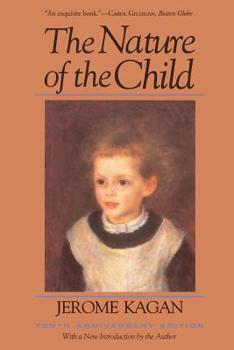The Nature of the Child (Tenth Anniversary Edition)
Select Format
Select Condition 
Book Overview
The world-famous Harvard psychologist challenges many of psychology's most deeply held assumptions about human development--arguing, for example, that early experience does not inexorably shape our lives and that the influence of the family is more subtle than has been supposed.
Format:Paperback
Language:English
ISBN:0465048528
ISBN13:9780465048526
Release Date:May 1994
Publisher:Basic Books
Length:352 Pages
Weight:0.90 lbs.
Dimensions:0.8" x 6.0" x 9.0"
Customer Reviews
2 ratings
Good book addressing important questions
Published by Thriftbooks.com User , 17 years ago
In the epilogue to his "The Nature of the Child," psychologist Jerome Kagan writes that ". . .the central theme hidden in and between the chapters of this book is that the person's interpretation of experience is simultaneously the most significant product of an encounter and the spur to the next." These interpretations can be manifest as schemas--a schema is ". . .a representation of experience that bears a relation to an original event" (categories, propositions, etc.). There are implications here for continuity and change in the understanding that people have of themselves and their worlds. Kagan contends that biology (e.g., the maturation of the central nervous system) and experience shape the development of children's psychological qualities and cognition. As children move into adolescence, experience becomes the dominant force. The interaction between biology and experience, Kagan insists, militates against the likelihood that the child's schemata and personal characteristics (e.g., aggressiveness) will have any necessary relationship to that child's adolescent and adult views. Put simply, early and middle childhood beliefs do not predict the views that an adult will hold. Biology provides one important part of the explanation. Biologists find that as one stage of development is left behind, its underlying structures may simply disappear and, hence, not be a part of new structures (e.g., certain sensory cells simply cease existence with the metamorphosis of the tadpole). Just so with psychological development. To illustrate, Kagan takes "separation anxiety" among one-year olds. Many psychologists treat this as a harbinger of probable later adult problems. In Kagan's view, this anxiety may be temporarily adaptive, but has no necessary future function or importance. In a survey of longitudinal studies, Kagan reports that ". . .long-term preservation [of various psychological entities] is minimal until late childhood." Admittedly, there does appear to be some continuity in psychological entities from late childhood (6 to 10 years of age), and, by itself, this would seem to be compatible with the primacy principle. Kagan explains the carryover in situational or structural--but not psychological--terms. That is, if the situations in which people find themselves remain reasonably constant as they move through the different stages of development, there is likely to be continuity. On the other hand, ". . .the evidence does imply that if the profiles created by early encounters are not supported by future and current environments, change is likely." Available data are supportive of Kagan's analysis. One of the most dramatic instances of this concerns individuals' personalities, normally assumed to be resistant to alteration. Moss and Susman survey a series of longitudinal studies of personality development and, in line with Kagan's argument, find that "Consistency is most obvious for personality characteristics that are endowed
good for provoking discussion about child development
Published by Thriftbooks.com User , 24 years ago
This is a book about psychological development. Here are the chapter titles, to give you a more specific idea: Guiding Themes in Human Development; The Infant; Connectedness; Establishing a Morality; The Emotions; The Generation of Thought; The Role of the Family.Kagan is known for his work on temperamental shyness in infants. In this highly theoretical work (supported by evidence in many cases, but of course we don't know what counterevidence is going unmentioned) he critiques several generally accepted premises about psychological development. He argues that there is NOT a strong connectedness between the qualities a person has at early stages of development and the qualities he or she has at much later stages. He argues for the primacy of emotion over logic in our development. He notes in the preface that "It is not what parents do to children or siblings do to each other that matters, but rather the intention the child imputes to those who act on and with him or her."Thought-provoking stuff even for us ordinary parents, not just professionals and academics, although the writing style is at times a little over the top. If you can tease out the point Kagan makes within each long paragraph, you'll find it worth discussing.






